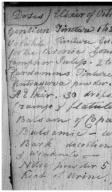[ Doses ] Sarah Creighton Wilkins
Date: Late 18th or early 19th century; exact date unknown.
Source:
Manuscript Notebook of Sarah Creighton Wilkins
Institution: Nova Scotia Archives
| Source Origin: MacDonald Family Fonds
| Reference: MG 1 No. 1 / Microfilm Reel 10,618
A list specifying dosages for a variety of medications and amounts for medicinal ingredients.
Doses | Elixir of Vitriol. 10 to 60. ^Adultdrops Stomachic Indigestion flatulence
_____
Gentian Tincture 1 to 2 drams in Water Stomachic & c. 3 or 4 times a day 3 doses
Volatile Tincture Guaiac gum 1 to 3 drams in water 2 or 3 times a day ditto
for the Chronic Gout & Rheumatism. --
Camphor Tulip. 2 to 4 Table Spoonfuls 3 times a day febrifuge Nervous fever
Cardamons Tincture 2 or 3 drams mint water, Stimulant Cramp &c.
Contrayerva powder. 20 to 40 grains in water. sudorific recent Cold.
A Ethir. 30 drops in Cold water Antispasmodic astma,
Cramp & flatulence
Balsam of Copaiva 20 to 30 drops in honey diuretic &
Balsamic - whites Glass & gravel
Bark decoction 3 or 4 Table spoonfuls 3 times day relaxation
& weakness --
Nitric powder 5 to 20 Grains in Barley water Strangury
heat of Urine fever. S[---] spirit 20 to 60 take for ditto
Download: Transcription | Images
